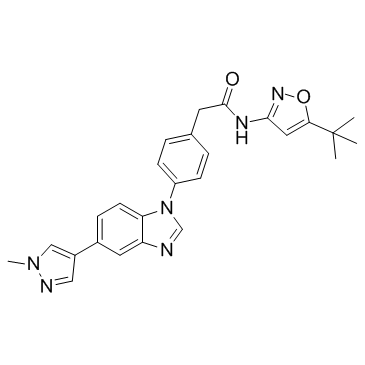| Description |
Pz-1 is a potent RET and VEGFR2 inhibitor with IC50s of less than 1 nM for both wild type kinases.
|
| Related Catalog |
|
| Target |
IC50: < 1 nM (RET and VEGFR2)[1]
|
| In Vitro |
Pz-1 is a Type-II tyrosine kinase inhibitor, able to bind the DFG-out conformation of the kinase. In cell-based assays, 1.0 nM of Pz-1 strongly inhibits tyrosine phosphorylation of VEGFR2 and clinically relevant RET mutants, including those refractory to vandetanib and cabozantinib (RETV804M and RETV804L)[1].
|
| In Vivo |
Pz-1 is shown active on VEGFR2, which can block blood supply required for RET-stimulated growth. At 1.0 mg/kg/day per os, Pz-1 abrogates formation of tumors induced by RET-mutant fibroblasts and blocks phosphorylation of both RET and VEGFR2 in tumor tissue. Pz-1 features no detectable toxicity up to 100.0 mg/kg, which indicates a large therapeutic window[1].
|
| Animal Admin |
Mice[1] In order to address in vivo RET-driven effects, Pz-1 is tested on tumors induced by oncogenic RET compared to a constitutively-active control Ras oncogene. Immunodeficient (nu/nu) mice are then injected with NIH3T3 RETC634Y or NIH3T3 HRasG12V cells and, before tumors have appeared, treated PO with Pz-1 (1.0, 3.0 or 10.0 mg/kg/day) or left untreated. Then the tumor effects are measured[1]
|
| References |
[1]. Frett B, et al. Fragment-Based Discovery of a Dual pan-RET/VEGFR2 Kinase Inhibitor Optimized for Single-Agent Polypharmacology. Angew Chem Int Ed Engl. 2015 Jul 20;54(30):8717-21.
|
